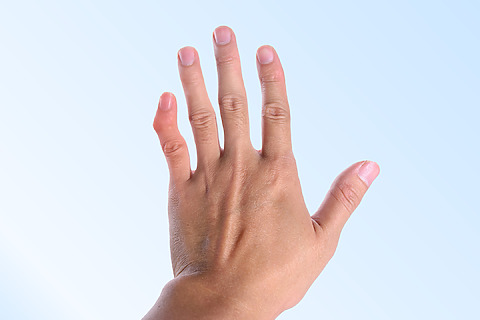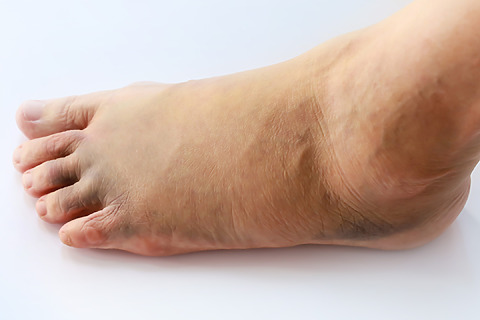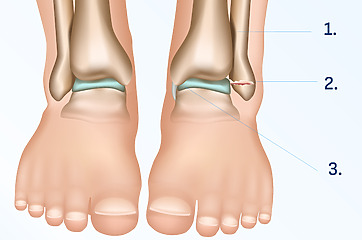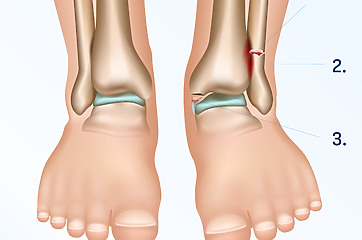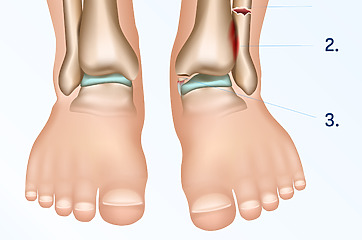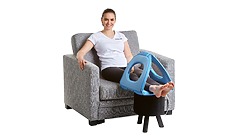Biomag - Encyclopedia - Fractures
Fractures - symptoms, description and treatment

Author MUDr. Peter Bednarčík CSc.
Revision
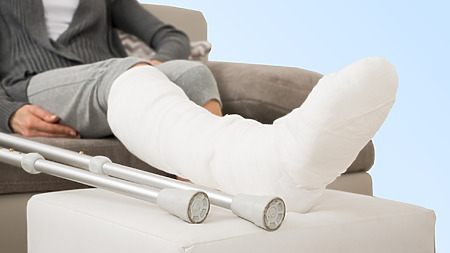
All of us have probably had the experience of suffering a fracture. A sharp pain after the injury, which increases is typical. Swelling, tingling, deformation or even bleeding are other symptoms. A fracture is painful. It brings many limitations and treatment is lasts weeks.
What to do when a it occurs and what to do to treat and heal it properly? What are the options for controlling symptoms such as pain, swelling or inflammation that accompany this condition? Read more here.
Fracture symptoms
The 6 most common symptoms or how to recognize it:
- Pain
- Swelling
- Bruise
- Limited mobility
- Deformity and abnormal position of the limb
- Bleeding (with open fracture) [1][2]
A patient with a fracture may also experience nausea and dizziness.[3]

Only a doctor can make a correct diagnosis. Do not use this or any other article on the internet to make a diagnosis. Do not delay seeing a physician and address your condition early.
Description and causes of fracture
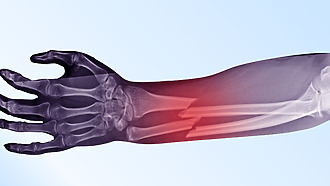
Defining a fracture
It is an injury to a bone that results in its complete or partial rupture. Fractures usually involve bones in the extremities. They can also occur in other parts of the body (for example, the spine, pelvis, or shoulder).[4] The disruption of the integrity of the bone can take many forms – the types of fracture vary depending on where and how the bone broke. [5]
Fractures occur most often in falls, injuries and accidents. Osteoporosis, a disease in which bones thin, can also be a cause. [6] Older age and an unhealthy lifestyle contribute to fractures. [7]
Fracture symptoms - photogallery
Types of fractures
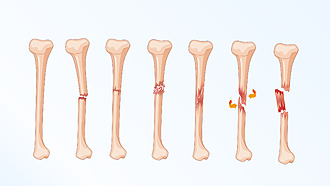
Fractures are divided into several groups according to what the fracture site looks like. Where parts of the bone are displaced or whether the bone penetrates through the skin.
- Closed
The bone stays under the skin and does not come out of the wound. - Open fracture
The bone penetrates the skin. - Dislocated fracture
Parts of the bone may shift in some fractures – for example, sideways or lengthways. - Stess fracture
It occurs, for example, due to long-term or unilateral stress. Athletes are typical patients with a fatigue fracture.[8]
Fractures can have different fracture lines. The bone may fracture transversely, obliquely or in a spiral. A splinter fracture can also occur.[9]
Risk factors
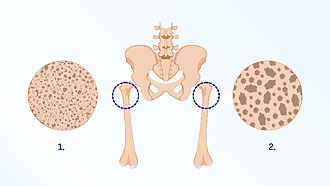
Osteoporosis (thinning of the bones) is a risk factor for fractures. It mainly affects people over 50 and women in the menopause.
- Osteoporosis makes bones brittle and more prone to fractures.
- Regular checking of bone density by densitometry will show the level of risk. Depending on the results of the examination, the doctor can recommend appropriate treatment. [10]
Fracture diagnostics
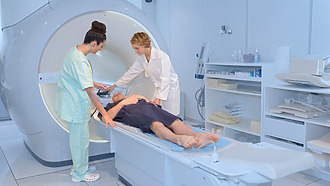
Diagnosis begins with a physical examination, during which the doctor examines and palpates the affected area.
- An X-ray will provide an accurate picture of the fracture.
- In some cases, magnetic resonance imaging (MRI) or computed tomography (CT) is also used.
- With these examinations, the doctor gets a detailed overview of the condition of the bone and surrounding tissues. [11]
Did you know?
- On average, each person suffers two fractures in a lifetime.[12]
- Most common fracture during working age is a wrist fracture..[13]
- Fracture of the femur (the longest bone in the body) affects up to 20 people per 100,000 population each year.[14]
Fracture complications
If treatment is not effective, it can cause a number of complications.
- Setting the bone in the wrong position: Can lead to deformity and limited mobility of the affected body part.
- Nerve and vascular damage: the nervous or vascular system may be damaged, leading to prolonged pain, numbness .
- Infection: open fracture can be a source of infection, which can lead to serious complications leading to sepsis (blood poisoning).
- Necrosis: If the blood circulation in the affected area is disrupted, bone tissue can be damaged and necrosis (death) of the tissue may occur.
- Functional limitations: mobility in the affected part of the body may be restricted, which may affect the patient’s overall quality of life.[15]
Limited mobility
Long-term pain and numbness
Infection
Necrosis

We recommend not postponing treatment of fractures
Do not delay treatment for a fracture and see a specialist if you have any health problems or doubts about your health. This will prevent unnecessary health complications.
Fracture treatment
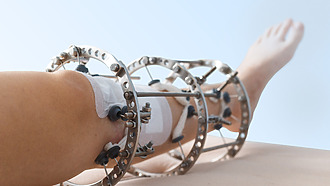
A broken leg or arm cannot go without treatment. The key is to fixate the fracture to provide rest for healing. Rest and elevated positioning also help to reduce swelling. In some cases, it is necessary to first set the broken bone in the correct position – either by manipulating the limb in the doctor’s office or surgically in the operating room.
- A plaster cast, splint or brace is used for basic fixation of the fracture.
- Various metallic materials are used in the surgical immobilisation of the fracture. It is reinforced either externally or internally using screws, wires and other metal devices. [16]

Beware
Treatment of the fracture can only be determined by your physician after considering your overall health. Therefore, do not use this article as a guide to treatment, which can only be determined by a physician.
Length of fracture healing
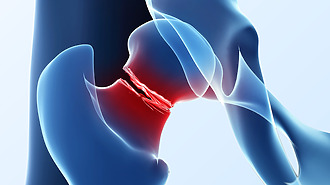
Each fracture has its own specific procedures for treatment. They also have different healing times.
- Broken ankle usually requires 6 to 8 weeks of treatment.
- Fracture of the femoral neck usually cannot be treated without hospital stay and surgery. Treatment can extend for up to several months. [18]
- Fracture of the clavicle is a common injury and in many cases is treated only with a sling on the arm. More complicated cases requires surgery. [19]
- Broken ribs usually heal spontaneously within 6 weeks. Patients must observe a resting regime and take care to breathe properly. Analgesics help.[20]
- Distal radius fracture is very common, especially in the elderly. This is a type of fracture of the bone that is located in the lower part of the forearm and attaches to the bone of the wrist. It can occur as a result of an injury such as a fall on the wrist. Its healing time can generally take 4-6 weeks. If it requires surgical treatment, the healing time is considerably longer.21]
- Less common fractures include pelvic fractures. Uncomplicated fractures heal without surgery within a few weeks, while serious pelvic fractures are a reason for urgent surgery. [22]
Broken Ankle – What is Weber Classification?
Patients often ask about Weber classification if they want to better understand their injury. This is used to assess the severity of the ankle fracture and how much the ankle has moved from its original location. It focuses on exactly where it is in relation to the syndesmosis – which is the articulation between two bones in the lower limb.
Ankle fractures according to the Weber classification are divided into three categories, depending on where they are located:
Type A: located below the syndesmosis.
Type B: passes through the syndesmosis.
Type C: located above the syndesmosis.
These three types of fractures can have different consequences and require different treatments. For example, a type C fracture may be the most severe because it may be associated with joint injury and require surgery.[23]
Medication
Analgesics and anti-inflammatory drugs are most commonly used in the treatment of fractures. Analgesics are commonly used drugs to relieve mild to moderate pain. Nonsteroidal anti-inflammatory drugs (NSAIDs) are another type of medication that can be used to relieve pain and inflammation.
In some cases, stronger analgesics such as opioids may need to be used if analgesics and NSAIDs are not effective.
First aid for fractures
The principles of first aid for a fracture include:
- Immobilization of the injured area (do not, however, try to set the broken bones to their original position),
- stopping bleeding in an open fracture (ideally with a sterile dressing),
- applying a cold compress to reduce swelling and relieve pain,
- checking the general condition of the injured person – after a fracture, shock may develop. [24]
If a fractured vertebra is suspected, do not move the injured person. It could cause irreversible changes to the spine and permanent damage to health. [25]
Physical therapy & rehabilitation
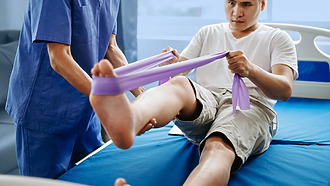
Treatment of the fracture is usually followed by physiotherapy. Properly selected exercises will ensure that the weakened muscles in the affected area become strong again.
The goal of rehabilitation is to fully restore mobility and movement. Specific exercises and type of physical therapy will be recommended by the physiotherapist. The length of rehabilitation depends on the type of fracture and the age of the patient. [26]
Nutrition in case of fractures
[27]
On the other hand, you should avoid smoking and excessive alcohol consumption – both of which have a negative impact on bone quality. [28]
Treatment of fractures can be supported by a balanced diet rich in calcium, protein and vitamin D. [27] On the other hand, you should avoid smoking and excessive alcohol consumption, both of which have a negative impact on bone quality. [28]
Fracture prevention
How to prevent fractures? The risk can be reduced primarily by lifestyle choices.
- Eat foods rich in calcium and protein.
- Don’t forget the importance of vitamin D, which promotes calcium absorption.
- Support bone quality and muscle mass with regular physical activity. [29]
- Create a safe home environment to minimise the risk of falls. This advice is especially important for the elderly. [30]

Important information when dealing with a fracture
When treating a fracture, it is necessary to provide immobilization of the broken bone and a resting regimen.
Treatment usually lasts several weeks and is followed by rehabilitation.
Adhere to all recommendations for fracture care, including any check-ups and X-rays.
Summary and recommendations for fractures
See a physician
The treatment of a fracture is always determined by a doctor based on a general examination, an assessment of your condition and an accurate diagnosis.
Causal treatment of fractures
After a general examination, your doctor will recommend treatment for the fracture. In connection with this, they will also recommend possible lifestyle modification and further treatment.
Reducing pain, swelling and promoting healing
Symptomatic treatment focuses on the manifestations or symptoms of the disease. Such treatment can significantly improve your quality of life and support comprehensive treatment as the disease progresses.
Sources, references and literature
[1] Brazier Y. What is a fracture? Medical News Today, 24. August 2021. Available at: https://www.medicalnewstoday.com/articles/173312
[2] Broken bone. MedLine Plus Medical Encyclopedia, 1. January 2022. Available at: https://medlineplus.gov/ency/article/000001.htm
[3] Brazier Y. What is a fracture? Medical News Today, 24. August 2021. Available at: https://www.medicalnewstoday.com/articles/173312
[4] Bone X-ray. RadiologyInfo.org. 15. April 2022. Available at: https://www.radiologyinfo.org/en/info/bonerad
[5] Brazier Y. What is a fracture? Medical News Today, 24. August 2021. Available at: https://www.medicalnewstoday.com/articles/173312
[6] Broken bone. MedLine Plus Medical Encyclopedia, 1. January 2022. Available at: https://medlineplus.gov/ency/article/000001.htm
[7] Once Is Enough: A Guide to Preventing Future Fractures. National Institutes of Health – Osteoporosis and Related Bone Diseases National Resource Center December 2018. Available at: https://www.bones.nih.gov/health-info/bone/osteoporosis/fracture
[8] Brazier Y. What is a fracture? Medical News Today, 24. August 2021. Available at: https://www.medicalnewstoday.com/articles/173312
[9] Fractures. Johns Hopkins Medicine. Available at: https://www.hopkinsmedicine.org/health/conditions-and-diseases/fractures
[10] Once Is Enough: A Guide to Preventing Future Fractures. National Institutes of Health – Osteoporosis and Related Bone Diseases National Resource Center December 2018. Available at: https://www.bones.nih.gov/health-info/bone/osteoporosis/fracture
[11] Fractures. Johns Hopkins Medicine. Available at: https://www.hopkinsmedicine.org/health/conditions-and-diseases/fractures
[12] Arm Injury Statistics. The Ohio State University. Available at: https://u.osu.edu/productdesigngroup3/sample-page/
[13] Arm Injury Statistics. The Ohio State University. Available at: https://u.osu.edu/productdesigngroup3/sample-page/
[14] Denisiuk M., Afsari A. Femoral Shaft Fractures. StatPearls [Internet]. Treasure Island (FL): StatPearls Publishing; January 2023. Available at: https://www.ncbi.nlm.nih.gov/books/NBK556057/
[15] Brazier Y. What is a fracture? Medical News Today, 24. August 2021. Available at: https://www.medicalnewstoday.com/articles/173312
[16] Brazier Y. What is a fracture? Medical News Today, 24. August 2021. Available at: https://www.medicalnewstoday.com/articles/173312
[17] Broken ankle. NHS, 11. March 2022. Available at: https://www.nhs.uk/conditions/broken-ankle/
[18] Broken hip. NHS, 8. February 2023. Available at: https://www.nhs.uk/conditions/broken-hip/
[19] Clavicle Fracture (Broken Collarbone). OrthoInfo, April 2022. Available at: https://orthoinfo.aaos.org/en/diseases–conditions/clavicle-fracture-broken-collarbone/
[20] Broken ribs. Mayo Clinic, 15. February 2023. Available at: https://www.mayoclinic.org/diseases-conditions/broken-ribs/diagnosis-treatment/drc-20350769
[21] Fractures of the distal end of the forearm. MUDr. Vlastimil Volf SANQUIS No.25/2003, p. 28. Available at: https://www.sanquis.cz/index2.php?linkID=art654
[22] Pelvic Fracture. Cedars-Sinai. Available at: https://www.cedars-sinai.org/health-library/diseases-and-conditions/p/pelvic-fracture.html
[23] How to recognize a broken ankle and what are the treatment options? MUDr. Michal Vilímovský, August 2022. Available at: https://cs.medlicker.com/2137-zlomeny-kotnik
[24] Fractures (broken bones): First aid. Mayo Clinic, 22. March 2022. Available at: https://www.mayoclinic.org/first-aid/first-aid-fractures/basics/ART-20056641?p=1
[25] Spinal Injury: First aid. Mayo Clinic, 2. February 2023. Available at: https://www.mayoclinic.org/first-aid/first-aid-spinal-injury/basics/art-20056677
[26] Brazier Y. What is a fracture? Medical News Today, 24. August 2021. Available at: https://www.medicalnewstoday.com/articles/173312
[27] Once Is Enough: A Guide to Preventing Future Fractures. National Institutes of Health – Osteoporosis and Related Bone Diseases National Resource Center December 2018. Available at: https://www.bones.nih.gov/health-info/bone/osteoporosis/fracture
[28] Brazier Y. What is a fracture? Medical News Today, 24. August 2021. Available at: https://www.medicalnewstoday.com/articles/173312
[29]Brazier Y. What is a fracture? Medical News Today, 24. August 2021. Available at: https://www.medicalnewstoday.com/articles/173312
[30] Once Is Enough: A Guide to Preventing Future Fractures. National Institutes of Health – Osteoporosis and Related Bone Diseases National Resource Center December 2018. Available at: https://www.bones.nih.gov/health-info/bone/osteoporosis/fracture
| Rate this article |
|
|
5/51 Reviewed by
|
How to control pain, swelling and promote healing?
The solution may be symptomatic treatment using pulsed magnetic therapy (PEMF therapy), which targets symptoms and signs such as pain, swelling and inflammation. In addition, such treatment can support comprehensive treatment and significantly improve quality of life.
Explaining the effects
The basic principle of Biomag 3D pulsed magnetic therapy (PEMF therapy) is the generation of electromagnetic pulses. These pulses penetrate through clothing and through the entire depth of the tissue to the point of targeted application. The pulses have specially developed biotropic parameters (e.g. frequency, shape, intensity) to best affect various health problems.
What are the effects of 3D magnetic therapy (PEMF therapy)?
- Helps relieve pain.
- Mitigates inflammation.
- Suppresses swelling.
How is the treatment applied?
The application is very simple. You select the desired therapeutic effect on the device and attach the attached applicator to the desired application site. Magnetic therapy is usually applied 2 times a day for 20 minutes.
We will be happy to help you try this method and advise you on which device to purchase.
